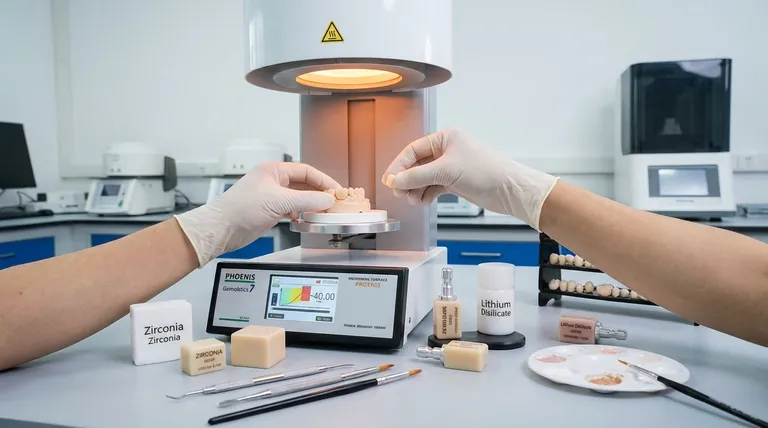Yes, dentists absolutely still use porcelain, but the term has evolved significantly. What your dentist calls "porcelain" today is typically a high-tech dental ceramic, a class of materials far superior in strength and versatility to the porcelain of previous decades.
The central takeaway is that "porcelain" is now a catch-all term for a family of advanced ceramics. The choice of material is a strategic decision that balances the need for brute strength (for back teeth) with the need for lifelike aesthetics (for front teeth).

The Evolution from Porcelain to Advanced Ceramics
The beautiful, natural-looking restorations available today are the result of decades of material science innovation. The journey began with a material that was aesthetically pleasing but mechanically weak and has progressed to materials that are nearly as strong as metal.
Traditional Feldspathic Porcelain
This is the original dental porcelain, renowned for its ability to be layered by a skilled technician to create stunningly realistic veneers and crowns. It perfectly mimics the translucency and subtle shades of natural enamel.
However, its weakness is its brittleness. While still considered the gold standard for aesthetics by some cosmetic dentists for veneers, it is rarely used for crowns on teeth that bear significant chewing force.
The Rise of High-Strength Ceramics
To overcome the fragility of traditional porcelain, material scientists developed new classes of all-ceramic materials. These options eliminate the need for a metal substructure, offering superior aesthetics without compromising durability.
A Guide to Modern Dental Ceramics
Today, dentists have a palette of advanced ceramic materials to choose from. The two most dominant are Zirconia and Lithium Disilicate, each with a distinct purpose.
Zirconia: The "Ceramic Steel"
Zirconia is a type of zirconium dioxide that is exceptionally strong and resistant to fracture. Its sheer durability makes it the ideal material for restorations that must withstand immense pressure.
It is the go-to choice for crowns on molars, long-span bridges, and implant-supported restorations. While early versions of zirconia were opaque, modern formulations have greatly improved translucency, making them more aesthetic than ever.
Lithium Disilicate (E-max): The Aesthetic Powerhouse
Lithium disilicate, commonly known by the brand name E-max, offers an exceptional blend of beauty and robustness. It is significantly stronger than traditional porcelain but more translucent and natural-looking than most zirconia.
This balance makes it the premier choice for restorations in the "esthetic zone"—the front teeth that are visible when you smile. It is used for veneers, inlays, onlays, and single crowns on front teeth.
Porcelain-Fused-to-Metal (PFM): The Old Guard
For decades, the PFM crown was the standard. It consists of a metal alloy core with a layer of porcelain baked on top to provide a tooth-like appearance.
While strong and reliable, PFM crowns are used less frequently today. The metal base blocks light, making them look opaque and unnatural compared to all-ceramic options. They can also cause a dark grey line to appear at the gumline over time.
Understanding the Trade-offs: Strength vs. Aesthetics
The selection of a dental ceramic is never arbitrary. It's a calculated decision based on the specific demands of the tooth being restored.
Why Zirconia Excels in the Back
Your molars can exert hundreds of pounds of force per square inch during chewing. This environment demands a material, like zirconia, that prioritizes fracture resistance above all else. Aesthetics are secondary to pure strength.
Why Lithium Disilicate Shines in the Front
Your front teeth don't require the same brute strength, but they are the focal point of your smile. A restoration must capture and reflect light exactly like a natural tooth. The superior translucency of lithium disilicate makes it the clear winner for achieving a seamless, lifelike appearance.
Making the Right Choice for Your Restoration
Understanding these materials empowers you to have a more informed conversation with your dentist about your specific needs and goals.
- If your primary focus is restoring a molar or supporting a bridge: Zirconia is likely the superior choice for its unmatched durability and fracture resistance.
- If your primary focus is the appearance of a front tooth: Lithium disilicate (E-max) offers the best combination of strength and lifelike, natural aesthetics.
- If your primary focus is a conservative, highly cosmetic veneer: A master ceramist may still use traditional feldspathic porcelain for ultimate artistic control over the final look.
Ultimately, discussing these modern ceramic options with your dentist will ensure your restoration is not only beautiful but also built to last.
Summary Table:
| Material | Primary Use | Key Characteristics |
|---|---|---|
| Zirconia | Molars, Bridges, Implants | Exceptional strength, fracture-resistant |
| Lithium Disilicate (E-max) | Front Teeth, Veneers | High aesthetics, balanced strength & translucency |
| Traditional Porcelain | Veneers (cosmetic focus) | Superior aesthetics, layered for realism |
| Porcelain-Fused-to-Metal (PFM) | Less common today | Metal core with porcelain coating, strong but less aesthetic |
Ready to find the perfect dental ceramic for your restoration? At KINTEK, we specialize in high-quality lab equipment and consumables that support the creation of precise, durable dental prosthetics. Whether you're crafting zirconia crowns or lithium disilicate veneers, our solutions help dental labs achieve exceptional results. Contact us today to learn how we can enhance your laboratory's efficiency and product quality!
Visual Guide

Related Products
- Vacuum Dental Porcelain Sintering Furnace
- Dental Porcelain Zirconia Sintering Ceramic Furnace Chairside with Transformer
- High Temperature Muffle Oven Furnace for Laboratory Debinding and Pre Sintering
- 1400℃ Laboratory Quartz Tube Furnace with Alumina Tube Tubular Furnace
- 1700℃ Laboratory Quartz Tube Furnace with Alumina Tube Tubular Furnace
People Also Ask
- What are five applications of soldering? From Electronics to Art, Master Material Joining
- What is the advantage of firing porcelain in a vacuum? Achieve Denser, Stronger, and More Aesthetic Dental Restorations
- What are the disadvantages of brazing? Key Challenges in Material Joining
- What temperature is porcelain fired at? A Guide to Precise Dental Firing Cycles
- What is the function of a porcelain furnace? Precision Firing for Lifelike Dental Restorations



















